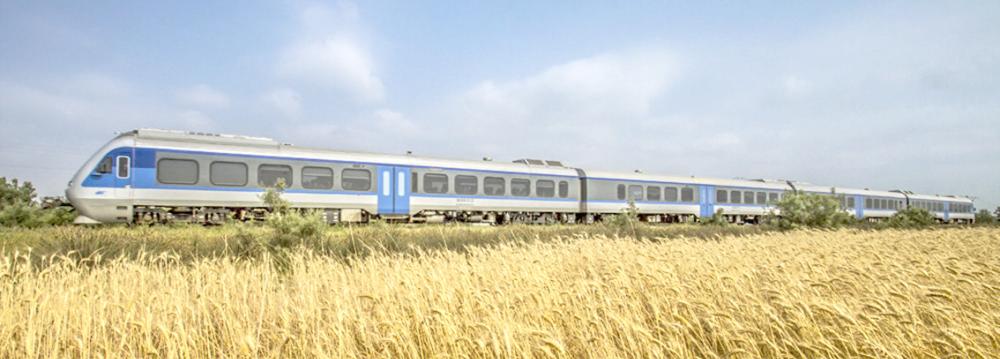Rail transport took center-stage in Monday’s parliamentary session.
MPs approved a bill to allocate 1% of oil revenues to the rail sector as part of the sixth five-year development plan (2016-21), IRNA reported.
Passed by 180 representatives in favor, four against and two abstentions, the bill requires the government to use the fixed share of oil-driven financial sources to implement new rail projects and develop existing ones, including double-tracking, electrification and construction of high-speed railroads.
Despite a plunge in oil revenues, which account for the lion’s share of the government’s income, allocating a fixed share of petrodollars to the country’s underdeveloped rail industry shows the government’s firm determination for expanding the domestic rail sector.
The 1% share of oil revenues will be added to resources provided by foreign and domestic private investors.
Iran has a long list of ongoing rail projects, as the country seeks to increase revenues from transit by becoming a transportation hub in the region.
“I believe we should do away with the oil-dependent economy and turn to transit-driven economy,” deputy minister of roads and urban development, Kheirollah Khademi, was quoted as saying by ILNA on Sunday. “Transit can be a replacement for oil revenues.”
Regional Connectivity Projects
Iranian railroads are being extended to neighboring countries.
A route to Azerbaijan will be inaugurated in three months while railroads to Iraq and Afghanistan are being built. These will follow a trilateral railroad inaugurated in 2015 connecting the railroads of Iran, Turkmenistan and Kazakhstan.
The connectivity projects are supposed to form corridors linking the free waters in southern Iran to the landlocked Central Asian states, Russia, Europe, China and the neighboring Middle Eastern countries.
Financial issues persist amid tight government budget as a result of fallen oil prices. Short in cash, several rail projects have made little progress in the past few years.
A route from Qazvin to Rasht in northern Iran with more than 90% progress is among the long-stranded projects. Its extension, from Rasht to Astara Port, close to Azerbaijan’s border, requires $500 million from Azerbaijan to complete a rail corridor that is part of a grand global transit project called International North-South Transport Corridor Project. It aims to connect India to Europe via Iran, Azerbaijan and Russia.
According to Khademi, Iran plans to add 1,000 kilometers of new railroads to its network in the near future. This indicates a significant rise in rail construction, compared to an average of 200 kilometers constructed annually over the past few years.
The parliament is currently discussing the Sixth Plan, based on which the existing railroads are to be electrified and double-tracked, and 1,500 km of new lines are to be constructed.
Based on the new parliamentary bill, the government is to increase the share of rail in cargo and passenger transportation to a minimum of 30% and 20% respectively by the end of the Sixth Plan.
Role of Domestic Manufacturers
Also on Monday, MPs approved a bill that requires the government to increase the share of domestic companies in the manufacture of equipment used in rail projects to at least 85% by the end of the five-year period (2021).
According to the new law, the government should “organize the foreign purchase of equipment in a way that exploitation of domestic capacity in manufacturing and services is maximized” and “technology is transferred into the country”.
Domestic companies have been lately signing joint venture agreements with international firms to start manufacturing train wagons inside Iran and reduce reliance on imports.
Iranian Rail Industries Development Company and Chinese rolling stock manufacturer Nanjing Puzhen Co. LTD. signed an agreement in Tehran in October to jointly manufacture 215 wagons for subway trains across Iran. Based on the agreement, IRIDC will be in charge of manufacturing the wagons.
Also in October, Germany’s Siemens signed a contract to upgrade Iran’s railroad network. Siemens said it would supply components for 50 diesel-electric locomotives to Iran’s MAPNA Group.
Another agreement was also signed between the two companies to jointly manufacture 70 electric locomotives for use in the 926-km Tehran-Mashhad railroads, which are being electrified.
As per Iran’s 20-Year Vision Plan (2005-25), the 2,250 wagons currently in use in the domestic rail fleet should be doubled by 2025. There is massive demand for new wagons, as a series of railroads are being built across the country.
The government of President Hassan Rouhani also plans to reduce the age of domestic rail fleet to 15 years to increase their efficiency.
Some of the wagons used in Iran’s fleet are more than 30 years old and 100% decrepit. To expand passenger transport via rail, the government needs to use wagons that are in decent conditions in terms of both accommodation and safety.
Experts believe Iran needs a minimum of 4,000 freight and 1,500 passenger cars within five years to renew its aging fleet, though the country cannot rely on limited manufacturing capacity to supply this volume.


